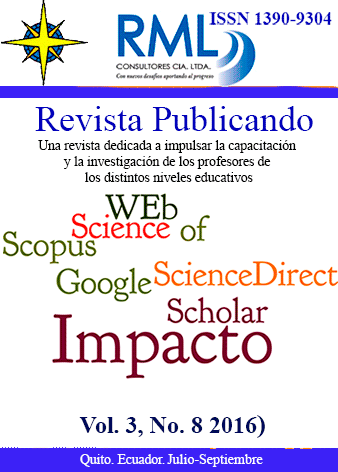Abstract
La investigación se propuso una revisión de la literatura científica reportada en el tema de la innovación abierta para poder establecer tendencias y la posible aplicación de dichos conceptos en la docencia universitaria actual en Administración de Empresas. A partir de una revisión de las fuentes reportadas en Scopus se realizó una búsqueda para la aparición del término “open innovation” que arrojó un total de 355 artículos concentrado mayoritariamente en el periodo entre 2011 y 2016. De la revisión realizada se pudo concluir que el mayor por ciento de trabajos se centra en la Ingeniería (28 %), seguido de Administración, Gestión y Contabilidad. El énfasis en la utilización de recursos tecnológicos, en relación con la Innovación Abierta apareció señalado desde los primeros años con un énfasis particular en el uso de recursos tecnológicos y la identificación de nuevas oportunidades y posibles socios externos e internos y a la vez a la utilización de estas posibilidades para registrar patentes unido a la posible comercialización que se derive de ello. Los trabajos relacionados con la Administración, la Gestión y la Contabilidad han estado en direcciones tan diversas como la posibilidad de creación de valor empleando la Innovación Abierta
La distribución de artículos por países reflejó que el país que más publica en el tema es la Federación Rusa, seguido de USA y Finlandia y el mundo da habla hispana ha publicado muy poco en relación con el tema. Para poder captar los papers seminales se procedió a partir de la misma herramienta que se encuentra en Scopus a determinar los artículos más citados, lo que permitió determinar que estos son las conferencias relacionadas con la Innovación Abierta.
References
Cid, R. G., de Vicente y Oliva, M. A., Manera Bassa, J., & Ania, A. R. (2011). Innovation efficiency and open innovation: An application to activity branches in Spain Open Innovation in Firms and Public Administrations: Technologies for Value Creation (pp. 175-190).
Conference of Open Innovation Association, FRUCT. (2014). Paper presented at the Conference of Open Innovation Association, FRUCT.
Conference of Open Innovation Association, FRUCT. (2015). Paper presented at the Conference of Open Innovation Association, FRUCT.
Conference of Open Innovation Association, FRUCT. (2016). Paper presented at the Conference of Open Innovation Association, FRUCT.
Corvello, V., Gitto, D., Carlsson, S., & Migliarese, P. (2013). Using information technology to manage diverse knowledge sources in open innovation processes Managing Open Innovation Technologies (Vol. 9783642316500, pp. 179-197).
Cravo, T. A. (2010). SMEs and economic growth in the Brazilian micro-regions. Papers in Regional Science, 89(4), 711-734. doi:10.1111/j.1435-5957.2010.00301.x
Chesbrough, H. W. (2003). Open Innovation: The New Imperative for Creating and Profiting from Technology. MA:Harvard Business School Publishing.
Chesbrough, H. W. (2006). The era of open innovation. Managing innovation and change, 127(3), 34-41.
de Pablos Heredero, C., & Berzosa, D. L. (2011). Open innovation in firms and public administrations: Technologies for value creation.
Enkel, E., Gassmann, O., & Chesbrough, H. (2009). Open R&D and open innovation: exploring the phenomenon. R&d Management, 39(4), 311-316.
Fernández y Fernandez, E., Mertins, K., Sequeira, C. A., & Will, M. (2012). Intellectual capital statements in Brazilian SME: Lessons learned from the first pilot-implementations. Paper presented at the Proceedings of the European Conference on Knowledge Management, ECKM.
Khomonenko, A., & Gindin, S. (2016). Performance evaluation of cloud computing accounting for expenses on information security. Paper presented at the Conference of Open Innovation Association, FRUCT.
Livieratos, A. D., Papoulias, D. B., & Petit, S. C. (2011). Developing an open innovation growth strategy for New Technology-Based Firms: The case of A-Lighting Open Innovation in Firms and Public Administrations: Technologies for Value Creation (pp. 248-274).
Maarse, J. H., & Bogers, M. (2011). An integrative model for technology-driven innovation and external technology commercialization Open Innovation in Firms and Public Administrations: Technologies for Value Creation (pp. 59-78).
Narcizo, R. B., Canen, A. G., & Tammela, I. (2012). SME's innovation capability as a resource to meet future logistical demands of brazilian oil industry. Paper presented at the International Conference on Industrial Logistics, ICIL 2012 - Conference Proceedings.
Noble, C. H., & Durmusoglu, S. S. (2014). Introduction: The Journey into Open Innovation. Open Innovation: New Product Development Essentials from the PDMA, xiii-xx.
Pagliarussi, M. S., & Rapozo, F. O. (2011). Agency relationships in a brazilian multifamily firm. Family Business Review, 24(2), 170-183. doi:10.1177/0894486511409573
Popov, S., & Chernyy, E. (2013). Developing of energy resources accounting and controlling system for the Internet of Things. Paper presented at the Conference of Open Innovation Association, FRUCT.
Shekar, A. (2014). Open Innovation: A Framework for Collaborative Product Development between Industry and Universities Open Innovation: New Product Development Essentials from the PDMA (pp. 225-255).
Stadlbauer, M., & Drexler, G. (2014). De-Bottlenecking Open Innovation: Turning Patent-Based Technology Network Analysis into Value Open Innovation: New Product Development Essentials from the PDMA (pp. 3-26).
Vieira, A., de Sousa Neto, c., nio, J. A., & Roscoe, M. T. (2011). The influence of culture on governance, innovativeness and knowledge generation in brazilian family businesses Understanding Entrepreneurial Family Businesses in Uncertain Environments: Opportunities and Resources in Latin America (pp. 66-90).
You are free to:
Share — copy and redistribute the material in any medium or format.
Adapt — remix, transform, and build upon the material.
The licensor cannot revoke these freedoms as long as you follow the license terms.
Under the following terms:
Attribution — You must give appropriate credit, provide a link to the license, and indicate if changes were made. You may do so in any reasonable manner, but not in any way that suggests the licensor endorses you or your use.
NonCommercial — You may not use the material for commercial purposes.
ShareAlike — If you remix, transform, or build upon the material, you must distribute your contributions under the same license as the original.
No additional restrictions — You may not apply legal terms or technological measures that legally restrict others from doing anything the license permits.
